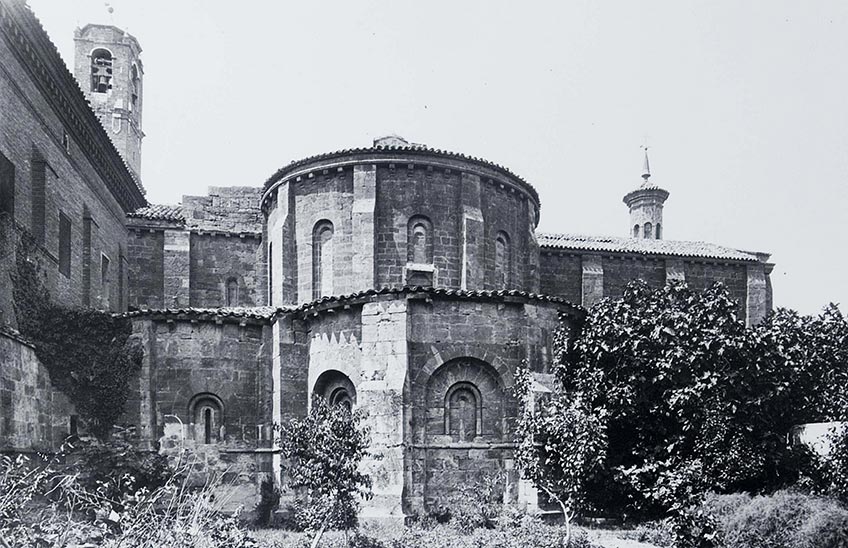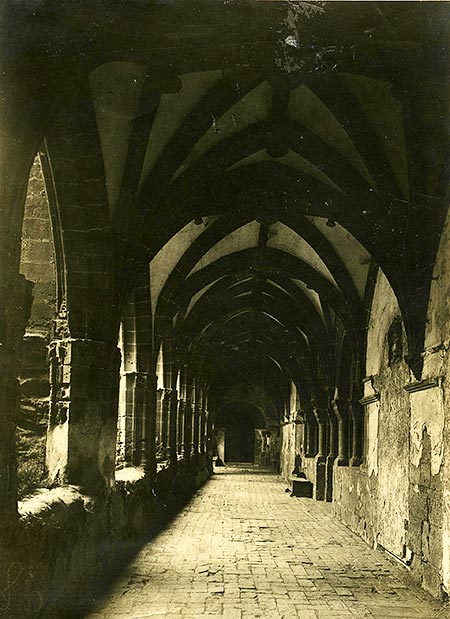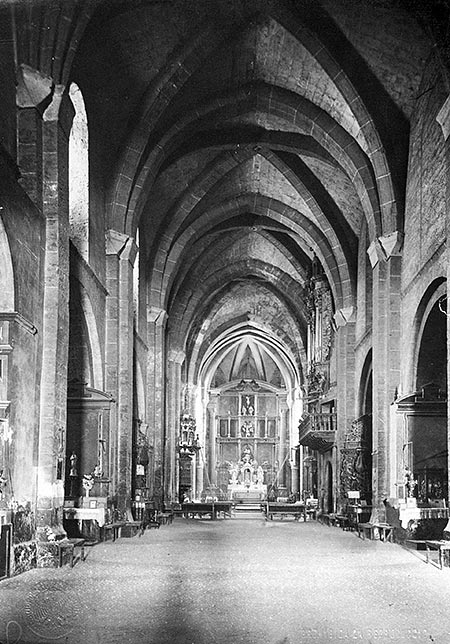Antecedentes para la declaración del monasterio de Fitero como <i>Monumento Nacional</i>, en 1931

FotoArxiuMas. Fototeca file General de Navarra/Ábsides of the church of the monastery of Fitero in 1916.
In June 1931 the church and cloister of the monastery of Fitero were declared by the Ministry with the highest category of National Monument. This designation had been the highest in Spanish legislation since 1844, when the Monuments Commissions were legislated on and León Cathedral was declared the first national monument. As is well known, in the 19th century, cultural heritage was symbolised in the so-called National Monuments, existing as "cultural objects", when the concept of "cultural heritage" did not yet exist. That cataloguing was replaced in 1985 by the figure of Bien de Interés Cultural, when the legislation already included the concept of "cultural property", which integrates all the significant manifestations and testimonies of all human activity, with a pre-eminent place for works of art and/or historical-artistic monuments.
The first to obtain this distinction in Navarre, between 1844 and 1927, were seven: the monasteries of Leire, Irache and La Oliva, the cathedral of Tudela, the Chamber of Comptos, the palace of Olite and the parish church of Santa María de Sangüesa.
The monastery of Fitero, along with seventeen other sites, including Pamplona cathedral, was granted the status of monastery in 1931. The monastery, along with seventeen other sites, including Pamplona cathedral, was given its time in 1931. The monastery had already been the subject of two separate proceedings dating from 1899-1901 and 1908, which, although they did not come to fruition, did represent an awareness on the part of different social sectors to protect an important architectural complex.
The first of these is preserved in its entirety at file Diocese of Tarazona, to whose mitre the town of Fitero belonged at the time. The promoters were the bishop of the diocese, Juan Soldevila y Romero and the parish of Fitero. By that time, Pedro Madrazo had published a few pages on the monastery, after visiting it on the occasion of a stay at the Spa. The closest reason for deciding to build transcript was the presence in the town of the president of committee of Ministers himself, the liberal Práxedes Mateo Sagasta, in July 1894. The politician must have visited the monastic complex and corresponded with the leaders of his party in Fitero. The impression made on Sagasta and Bishop Soldevilla himself by the recently collapsed sections of the lower cloister (1893) was a circumstance that the local authorities took advantage of.

Cloister of the cloister of the monastery of Fitero in 1916. Mas Archive. Photographic library file General de Navarra
The transcript was started in June 1899. In one of the letters, the Minister of Public Works reported the approval of the Royal Academy of History of the mandatory report, while awaiting the approval of the Academy of San Fernando. From the latter institution, the architect Enrique María Repullés was the one who was to draft the corresponding text, but he did nothing but put up all kinds of obstacles subject to travel to Fitero and asked for photographs in order to give his judgement. The photographs were ordered and sent to Madrid with explanatory notes taken from the aforementioned book by Madrazo. The photographs were of no use, as Repullés issued an unfavourable opinion with the argument that "there are already other monuments of this subject declared and other buildings of greater value".
The displeasure of report of the academician of San Fernando led both the bishop of Tarazona and the local authorities to turn directly to Sagasta, who responded by recommending patience and waiting for the Count of Romanones, who had held the post of Minister of Public Instruction since 1901, to improve. bequest Shortly afterwards, Sagasta retired from politics and the most pressing needs were covered with a 5,000 pesetas from the bequest estate of Doña Josefa Octavio de Toledo.
The second transcript in order to achieve the category of National Monument dates from 1908 and is conserved in the file Municipal de Fitero. At that time there was a new circumstance to take into account, the visit and knowledge in situ of the monastery by Vicente Lampérez y Romea, which led to the publication in the bulletin of the Royal Academy of History of a monographic work on the church in 1905, including plans, photographs, elevations and drawings. Lampérez, one of the great historians of Spanish architecture, had written: "The architecture of the Cistercian monastery produced nothing so grandiose in Spain".
On this occasion it was the mayor, Eloy Andrés, who wanted to take advantage of his influence, in this case with the deputy to the Cortes for the district of Tudela, Lorenzo Sáenz y Fernández. A written request signed by the municipal corporation and the parish priest Martín Corella was sent to the Minister of Public Instruction and Fine Arts, supported by textual phrases from Lampérez's text.
The good expectations did not prosper and the declaration remained pending until the favourable resolution dated 1931, within the large group of buildings declared that year.

Interior of the monastic church of Fitero in 1916. Mas Archive. Photographic library file General de Navarra
To find out more
FERNÁNDEZ GRACIA, R., "Un largo camino hasta la declaración del monasterio de Fitero como Monumento Nacional en 1931", Fitero: el bequest de un monasterio, Pamplona, Fundación para la Conservación del Patrimonio Histórico de Navarra, 2007, pp. 381-382.
GONZÁLEZ VARAS, I., Conservación de bienes culturales: teoría, historia, principios y normas, Madrid, Chair, 2005.
QUINTANILLA MARTÍNEZ, E., La Comisión de Monumentos históricos y artísticos de Navarra, Pamplona, Gobierno de Navarra, department de Education y Cultura, 1995.
